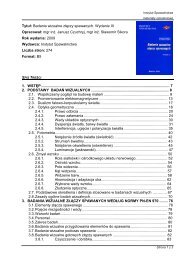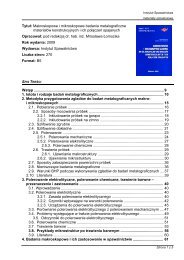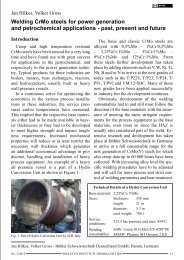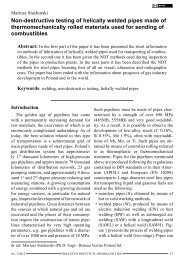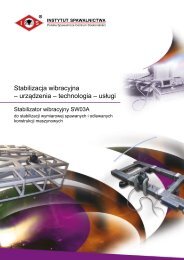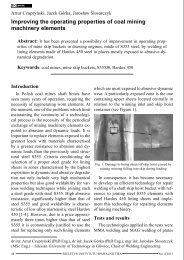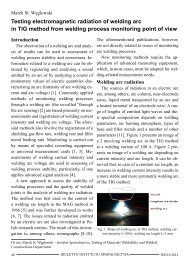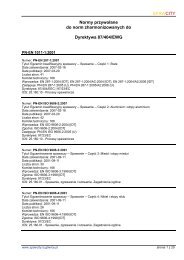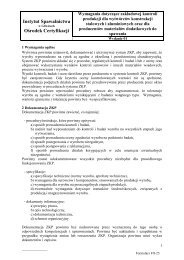Damping factor function in AC electrical arc models. Part 1. Heat ...
Damping factor function in AC electrical arc models. Part 1. Heat ...
Damping factor function in AC electrical arc models. Part 1. Heat ...
You also want an ePaper? Increase the reach of your titles
YUMPU automatically turns print PDFs into web optimized ePapers that Google loves.
Antoni Sawicki<strong>Damp<strong>in</strong>g</strong> Factor Function <strong>in</strong> <strong>AC</strong> Electrical Arc Models<strong>Part</strong> 1: <strong>Heat</strong> Process Relaxation Phenomena,their Approximations and MeasurementIntroductionTemporary changes of the columncross-section radius and the distribution ofenergy along and across an <strong>arc</strong> significantlyaffect the operation of electrotechnologicaldevices and electric appliances. They aredecisive for the possibility of break<strong>in</strong>g andre-ignit<strong>in</strong>g the <strong>arc</strong>. A quantity characteris<strong>in</strong>gsuch possibilities <strong>in</strong> the most complete manneris a <strong>function</strong> for the <strong>factor</strong> of damp<strong>in</strong>genergetic processes <strong>in</strong> an electric <strong>arc</strong> plasma.A coarse, and yet very comfortable approximationof this <strong>function</strong> is the time constant.The knowledge of the <strong>arc</strong> time constant isnecessary for the follow<strong>in</strong>g:• select<strong>in</strong>g economical operat<strong>in</strong>g conditionsof electrotechnological devices (weld<strong>in</strong>g,electrothermal etc.);• optimum <strong>in</strong>fluence on the <strong>arc</strong> <strong>in</strong> switch<strong>in</strong>gdevices (breakers, switches, contactors,relays);• maximally <strong>in</strong>tense <strong>in</strong>fluence on the <strong>arc</strong> <strong>in</strong>overcurrent and overvoltage protectivedevices (fuses, lightn<strong>in</strong>g protectors).The <strong>arc</strong> may stop dur<strong>in</strong>g voltage reduction,excessive stretch<strong>in</strong>g of the column, excessivecurrent reduction, cool<strong>in</strong>g of the gasarea (sometimes also of the electrode) or asa result of contract<strong>in</strong>g the column with a diaphragm.The above phenomena trigger deionisation<strong>in</strong> the plasma column and cool<strong>in</strong>g ofthe active areas <strong>in</strong> the electrodes. Depend<strong>in</strong>gon the <strong>in</strong>tensity and duration of these processes,re-ignition of the <strong>arc</strong> may be difficultor even impossible. For this reason, the timeconstant should be the follow<strong>in</strong>g:• low <strong>in</strong> electric appliances so that the <strong>arc</strong>can stop relatively quickly due to disturbances;• high <strong>in</strong> electrotechnological equipment, <strong>in</strong>order to prevent undesired term<strong>in</strong>at<strong>in</strong>g ofthe <strong>arc</strong> due to disturbances.<strong>Heat</strong> process relaxation phenomena<strong>in</strong> electric <strong>arc</strong>Arc columns have a heat capacity, and yetthey constitute certa<strong>in</strong> resistance to thermalcurrent. For this reason they have f<strong>in</strong>ite timesof response to forced changes of thermalstates. The amount of <strong>in</strong>ternal energy, accumulated<strong>in</strong> the <strong>arc</strong>, depends on many <strong>factor</strong>s:• plasma volume (radius, length and shapeof the column);• temperature distribution <strong>in</strong> the column;• pressure of the plasma-form<strong>in</strong>g gas;• type of plasma-form<strong>in</strong>g gas, degree ofplasma-form<strong>in</strong>g gas ionisation etc.The enthalpy of the <strong>arc</strong> Q changes exponentially<strong>in</strong> time <strong>in</strong> accordance with the timeconstant [1]θ =dP0−dQ1dRIdQ2(1)where P 0 – dissipated power; R – <strong>arc</strong> resistance.Hence one can see that θ depends oncurrent I. In the case of alternat<strong>in</strong>g current,the <strong>factor</strong> θ depends on the momentary valueof current.As the electric current is characterised bythermal <strong>in</strong>ertia, the changes of the thermalstate and geometrical dimensions of the col-dr hab. <strong>in</strong>ż. Antoni Sawicki, professor at Częstochowa University of Technology - Facultyof Electrical Eng<strong>in</strong>eer<strong>in</strong>gNo. 2/2013 BIULETYN INSTYTUTU SPAWALNICTWA37
umn dur<strong>in</strong>g current rushes or changes <strong>in</strong> thecolumn length are not immediate, but proceedwith a certa<strong>in</strong> time constant. That is why<strong>arc</strong> resistance dur<strong>in</strong>g the changes of currentr(i) alters exponentially from the stabilisedvalue r(I 0 ) to the value correspond<strong>in</strong>g to newcurrent r(I 1 ). The time constant of the <strong>arc</strong> <strong>in</strong>constant pre-set heat transfer conditions is atime after which the <strong>arc</strong> column changes itsresistance e–times after energy is no longersupplied to the column.The time constant of the <strong>arc</strong> is def<strong>in</strong>ed bythe column cool<strong>in</strong>g conditions. In plasmatronsit is shorter by 2÷3 orders (10 -6 ÷10 -7s) if compared with ord<strong>in</strong>ary free <strong>arc</strong>s. Evenat a frequency of 200 kHz the <strong>arc</strong>s of <strong>AC</strong>plasmatrons have a hysteresis, which reflectstheir low time constant. The higher the flowrate of the gas flow<strong>in</strong>g around the column orthe rate of the <strong>arc</strong> motion <strong>in</strong> gas, the lowerthe time constant is. In the case of high gasflow rates, the <strong>arc</strong> time constant does not dependon the gas chemical composition or thetype of electrodes [2].When the <strong>arc</strong> is ignited or term<strong>in</strong>ated theenergy accumulated <strong>in</strong> the plasma volumeunit is greater than the energy dissipatedfrom this volume. For this reason, <strong>in</strong> furnaceswith a high temperature of the atmosphereit is easy to observe the thermal breakdownof the <strong>in</strong>ter-electrode gap with relatively lowvoltage. In turn, if the temperature of the atmosphereis low, the reproduc<strong>in</strong>g strengthof the <strong>in</strong>ter-electrode gap rises quickly to acerta<strong>in</strong> <strong>in</strong>itial value accord<strong>in</strong>g to a certa<strong>in</strong> exponentialdependence. In order to be able toreliably re-ignite the <strong>arc</strong>, the rate of powersource voltage reproduction should be higherthan the critical value [1]. This pr<strong>in</strong>ciple isthe basis for test<strong>in</strong>g and assess<strong>in</strong>g the qualityof dynamic characteristics of weld<strong>in</strong>gsources. The lower limit of the reproduc<strong>in</strong>gvoltage is def<strong>in</strong>ed by the <strong>arc</strong> ignition voltage.The rate of <strong>in</strong>creas<strong>in</strong>g reproduc<strong>in</strong>g strengthof the <strong>arc</strong> column is def<strong>in</strong>ed by the <strong>in</strong>ertia ofheat processes, and especially by the <strong>arc</strong> timeconstant θ. In turn, the dynamic properties ofthe source are affected by the design and sett<strong>in</strong>gsof the control system as well as by thepassive conservative elements (<strong>in</strong>ductanceand capacitance) of its circuits.The gas suppression ability is def<strong>in</strong>ed notonly by its time constant but also by its electricstrength. The reproduction of the electricstrength of the <strong>in</strong>ter-electrode section stronglydepends on the fall<strong>in</strong>g rate of temperatureT of the plasma left after the <strong>arc</strong> column. Thiscan be roughly determ<strong>in</strong>ed us<strong>in</strong>g the follow<strong>in</strong>gdependence [1]:ot−θ( T −T) ⋅etT = T −0 (2)otwhere T ot – ambient temperature; T 0 – temperatureon the <strong>arc</strong> axis at the beg<strong>in</strong>n<strong>in</strong>g ofthe process; θ - <strong>arc</strong> time constant. The electricstrength of the <strong>in</strong>ter-electrode gap is <strong>in</strong>verselyproportional to temperature [1]TotET= Eot(3)Twhere E T – electric strength at heightenedtemperature T; E ot – electric strength at ambienttemperature T ot .Approximat<strong>in</strong>g the <strong>factor</strong> of energeticprocess damp<strong>in</strong>g <strong>in</strong> electric <strong>arc</strong>In the majority of simplified mathematical<strong>models</strong>, very roughly approximat<strong>in</strong>g thephysical properties of the electric <strong>arc</strong>, thedamp<strong>in</strong>g <strong>factor</strong> value of transitory processes(thermal and electric) is adopted as a constantquantity (the so-called time constant).It is the proportion of two quantities; thenumerator is the heat capacity of the plasmachannel, whereas the denom<strong>in</strong>ator is madeup of parameters specify<strong>in</strong>g the properties ofenergy dissipation [3]. More accurate <strong>models</strong>(e.g. Cassie-Mason or Lowke’s) b<strong>in</strong>d proportionallythe time constant value with thecross-sectional area of the plasma column[4, 5]38 BIULETYN INSTYTUTU SPAWALNICTWANo. 2/2013
∝2(4)where p - gas density; c p – specific heat ofgas of pressure p; λ - gas heat conduction<strong>factor</strong>; r a – <strong>arc</strong> column radius.The confirmation of this assumption wasalso attempted us<strong>in</strong>g the approximation ofexperimental data [6], where one should bear<strong>in</strong> m<strong>in</strong>d that the column cross-sectional areadepends not only on electric current <strong>in</strong>tensitybut also on the type and pressure of plasma-form<strong>in</strong>ggas, the temperature of the gas <strong>in</strong>the discharge area, the rate and direction ofgas flow, the diameter of the discharge duct,the amplitude and frequency of the magneticfield etc. In some other <strong>models</strong> of the <strong>arc</strong> thetime constant is adopted as be<strong>in</strong>g proportionalto the column diameter (e.g. the model byA.A. Woron<strong>in</strong> [7-10]).In relation to relatively long <strong>arc</strong>s the shortconical part at the cathode is negligible andthe shape of the whole plasma column can beassumed as cyl<strong>in</strong>drical. Theoretical deliberationsand experimentation are significantlysimplified if one determ<strong>in</strong>es the geometricaldimensions of the DC <strong>arc</strong>. Results obta<strong>in</strong>ed<strong>in</strong> this way can be adopted for low-frequency<strong>AC</strong> <strong>arc</strong>s, assum<strong>in</strong>g the necessity of ma<strong>in</strong>ta<strong>in</strong><strong>in</strong>gwith<strong>in</strong> them the same plasma equilibrium.In weld<strong>in</strong>g <strong>arc</strong>s the diameter of the <strong>arc</strong>column is, first of all, the <strong>function</strong> of currentd a = f(I 2/3 ) [11, 12]. This <strong>function</strong> is veryclose to the empirical formula [1]≅ × , cm (5)where n = 0.6÷0.7, obta<strong>in</strong>ed <strong>in</strong> the case of gasflow<strong>in</strong>g around the <strong>arc</strong> <strong>in</strong> a longitud<strong>in</strong>al manner.If the <strong>arc</strong> is <strong>in</strong> the air, k = 0.27 cm×A -n .If one considers a strong-current <strong>arc</strong>, e.g.<strong>in</strong> a steelmak<strong>in</strong>g <strong>arc</strong> furnace with a graphitecathode, burn<strong>in</strong>g <strong>in</strong> air, the measured columndiameter amounts to approximately [13]:2 ⎛z0,864 0,253 ⎟ ⎞d ⎜a= rK⋅ −⎝rK⎠(6)0,5In most operation regimes the gas atmosphereof the DC <strong>arc</strong> furnace is made up bycarbon oxides. Another formula for the diameterwas provided by R.T. Jones and Q.G.Reynolds [14]:da⎡ ⎛ z ⎞⎤2 r ⎢⎜⎟K ⋅ 3,2 − 2,2exp − ⎥ (7)⎣ ⎝ 5r⎠⎦= Kwhere the cathode spot radius isrKI= , cm(8)π jKand j K = 3500 A/cm 2 – current density <strong>in</strong> thecathode spot.However, the <strong>function</strong> of the column diameterd a (i) is not monotonic <strong>in</strong> the rangeof weak currents. Plasma does not disappearalong with the momentary reduction of currentto zero. Yet, the weaken<strong>in</strong>g of the p<strong>in</strong>cheffect may cause its expansion, accompaniedhowever by some cool<strong>in</strong>g and deteriorationof electric conductance. This, <strong>in</strong> turn,depends on the conditions of heat exchange<strong>in</strong> the environment and the rate of currentchanges dur<strong>in</strong>g polarisation alteration. Suchbehaviour is confirmed by the experimentaltests of the <strong>arc</strong> time constant, which <strong>in</strong>creasessignificantly <strong>in</strong> the range of weakcurrents, below approximately 18-30 A [15,16]. The flow of current through such term<strong>in</strong>ated<strong>arc</strong> plasma is possible after apply<strong>in</strong>gvoltage from an additional source [17]. Ifcurrents are weak, the <strong>arc</strong> time constants arenot only high but also strongly dependent onthe type of gas (e.g. <strong>in</strong> elgas, SF 6 , θ = 1÷2 µs,<strong>in</strong> the air θ = 100÷200 µs). In the range ofstrong currents the tendencies of time constantchanges are reverse to the changes ofcolumn diameter (cross-sectional area). An<strong>in</strong>crease <strong>in</strong> current <strong>in</strong>tensity as well as an<strong>in</strong>crease (with very weak saturation) <strong>in</strong> thecolumn diameter <strong>function</strong> (formulas (5)-(7))are accompanied by a decrease <strong>in</strong> the timeconstant, which stabilises at the lowest lev-No. 2/2013 BIULETYN INSTYTUTU SPAWALNICTWA39
ule, at such a moment this value matches themaximum damp<strong>in</strong>g <strong>factor</strong> value. The saidvalue can be determ<strong>in</strong>ed by means of appropriatemeasurement methods [21] utilis<strong>in</strong>gthe delay and <strong>in</strong>crease <strong>in</strong> the re-ignitionvoltage. From the po<strong>in</strong>t of view of ensur<strong>in</strong>gthe <strong>arc</strong> burn<strong>in</strong>g stability and the cont<strong>in</strong>uityof electrotechnological device operation itis justified to experimentally determ<strong>in</strong>e suchhighest value θ. Due to the range of weakcurrent, this constant can be used <strong>in</strong> the Mayrmodel. However, the time constant determ<strong>in</strong>ed<strong>in</strong> the weak-current range is sometimesalso used <strong>in</strong> the Cassie model [22], whichmay lead to discrepancies of experimentationand calculation results, especially <strong>in</strong> therange of strong currents. Therefore, if it isnecessary to precisely reproduce the courses<strong>in</strong> circuits by means of the universal modelof strong-current <strong>arc</strong> (e.g. hybrid TWV), thewhole damp<strong>in</strong>g <strong>factor</strong> <strong>function</strong> θ(i) shouldbe expressed by means of dependence.Experimental methods for determ<strong>in</strong><strong>in</strong>g<strong>AC</strong> <strong>arc</strong> dynamic parametersA characteristic feature of experimentalmethods for determ<strong>in</strong><strong>in</strong>g <strong>arc</strong> dynamic parametersis to take <strong>in</strong>to account the wholerange of physical phenomena tak<strong>in</strong>g place <strong>in</strong>the column, near-electrode areas and <strong>in</strong> electrodesthemselves. The separation of <strong>in</strong>dividualcomponents of energy processes is verydifficult but sometimes possible by means ofanalysis [11, 23, 24]. Depend<strong>in</strong>g on the designand the pr<strong>in</strong>ciple of operation of electrotechnological<strong>arc</strong> or plasma-<strong>arc</strong> devices,applied technologies and operation modes,one can observe various levels of disturbancesboth as to the amplitude and the range offrequency, which can even exceed the valuesallowed by related standards. Such disturbancesmay orig<strong>in</strong>ate from sources which aredifficult to identify or elim<strong>in</strong>ate and whichdisturb processes tak<strong>in</strong>g place <strong>in</strong> the <strong>arc</strong> column,electrodes, and even <strong>in</strong> the circuits ofmeasurement systems. As the quantities u(t)and i(t) are registered along with random disturbances,calculat<strong>in</strong>g the values of conductanceg(t) on their basis comes down to solv<strong>in</strong>ga badly conditioned task. An improvement<strong>in</strong> the quality if <strong>in</strong>put data can be obta<strong>in</strong>edus<strong>in</strong>g appropriate methods for filter<strong>in</strong>g andsmooth<strong>in</strong>g time courses [25]. However, priorto undertak<strong>in</strong>g such actions it is necessary tosolve the issue of recognis<strong>in</strong>g types of disturbances<strong>in</strong> order to weaken only the impact ofnatural disturbances and leave disturbancestriggered on purpose.Methods for determ<strong>in</strong><strong>in</strong>g the dynamic parametersof the <strong>AC</strong> <strong>arc</strong> can be divided <strong>in</strong>toseveral groups:1) methods us<strong>in</strong>g natural periodic courses ofcurrent and voltage;2) methods <strong>in</strong>troduc<strong>in</strong>g additional disturbancesto periodic courses, us<strong>in</strong>g additionalcurrent sources;3) methods <strong>in</strong>troduc<strong>in</strong>g disturbances of the<strong>arc</strong> column length (voltage);4) methods <strong>in</strong>troduc<strong>in</strong>g disturbances of conditionsof energy dissipation from the column[7, 21].In the case of the methods utilis<strong>in</strong>g naturalelectric courses it is assumed that there is anunequivocal <strong>function</strong>al relationship between<strong>arc</strong> parameters and current, resistance or conductance.It means that, <strong>in</strong> specified conditionsof heat<strong>in</strong>g and cool<strong>in</strong>g the column, oneset of model parameters corresponds to onevalue of current or <strong>arc</strong> conductance. Us<strong>in</strong>gproperly processed (filtered and/or smoothed)data, one can apply one of the analytical oranalytical-graphic methods (known as Ams<strong>in</strong>ck,Ruppe, Asturian, Rijanto, Zuckler, Tajew,generalised etc.) <strong>in</strong> order to determ<strong>in</strong>ethe simple parameters of the Mayr or Cassie<strong>models</strong> [22]. More complex <strong>models</strong> requirethe use of numerical methods.There are also possibilities of the directdeterm<strong>in</strong>ation of the <strong>arc</strong> time constant, notrequir<strong>in</strong>g the calculations of the rema<strong>in</strong><strong>in</strong>gNo. 2/2013 BIULETYN INSTYTUTU SPAWALNICTWA41
parameters of specific mathematical <strong>models</strong>.In the low-voltage <strong>arc</strong>s of s<strong>in</strong>usoidal alternat<strong>in</strong>gcurrent and <strong>in</strong> the conditions ofrelatively low cool<strong>in</strong>g <strong>in</strong>tensity, before andafter the passage of current through zero, itis possible to observe moments at which thefirst voltage derivative, <strong>in</strong> relation to time,equals zero. Us<strong>in</strong>g the measurement of timet0 from the moment at which s<strong>in</strong>usoidal currentpasses through zero until the moment of<strong>arc</strong> ignition or term<strong>in</strong>ation it is possible todeterm<strong>in</strong>e the whole time constant us<strong>in</strong>g thefollow<strong>in</strong>g formula [21]:t 0θ =(11)2Another simple method uses the harmonicanalysis of <strong>arc</strong> voltage [26]1 ⎛ 1 ⎞θ = ⎜ − χ ⎟4ω⎝ χ ⎠(12)where χ = A 2n+1 / A 2n-1 < 1 amplitudes of theclosest harmonic odds of voltage (usu. χ =A 3 / A 1 ).A special method for test<strong>in</strong>g the <strong>AC</strong> <strong>arc</strong>consists <strong>in</strong> “plac<strong>in</strong>g” a properly selectedhigh-frequency current (as to the amplitudeand phase) on the current flow<strong>in</strong>g through the<strong>arc</strong> [7]. For the purpose of test<strong>in</strong>g air switchesthis frequency usually amounts to 20 kHz. Inthe case of switches with elgas the frequencyis much higher and equals 70 kHz. In thismanner one can trigger additional transitionprocesses <strong>in</strong> the areas of net current passagethrough zero. After register<strong>in</strong>g the courses,the parameters of the Mayr model [7] can becalculated from the follow<strong>in</strong>g dependence:= − , if =0 (13)= , if =0 (14)where P M – constant value of the dissipatedpower of the model. As the determ<strong>in</strong>ation ofthe time constant is carried out at po<strong>in</strong>t i = 0,when conductance g has an <strong>in</strong>def<strong>in</strong>ite value,the value of the time constant <strong>in</strong> the expression(13) is calculated from the follow<strong>in</strong>g <strong>in</strong>terpolation:( t − ∆t) + g( t + ∆ )g0 0tg = (15)2where t 0 – time <strong>in</strong>stant <strong>in</strong> which i = 0 A; Δt –time <strong>in</strong>terval, at which the record<strong>in</strong>g of currentand voltage values takes place.Accord<strong>in</strong>g to another method, net currentdoes not have to pass through zero. In sucha case the value of power is determ<strong>in</strong>ed us<strong>in</strong>gthe formula (14), and the time constant iscalculated from the dependence below:2g ⎛ i ⎞θ = −⎜ −1⎟(16)dg⎝ gP M ⎠dtIt is also possible to determ<strong>in</strong>e the damp<strong>in</strong>g<strong>factor</strong> <strong>function</strong> on the basis of the reaction ofthe <strong>arc</strong> column on various length disturbances.They should also be appropriately synchronisedand shifted <strong>in</strong> the phase <strong>in</strong> relationto the course of current. In laboratory conditionsthe changes of length can be relativelyeasy to <strong>in</strong>duce by means of properly selectedrotat<strong>in</strong>g electrodes (commutators) [7]. Theexcitation of high-frequency disturbances byelectrode vibrations is more difficult, especiallyif electrodes are massive. It also facilitatesthe sputter<strong>in</strong>g of electrode material and<strong>in</strong>creases electrode erosion. A relatively highfrequency of such changes can be obta<strong>in</strong>edby the crosswise action of variable magneticfield on the <strong>arc</strong> [27]. Due to some b<strong>in</strong>d<strong>in</strong>g ofthe column to electrode spots (especially ofthe cathode) only the central part of a long<strong>arc</strong> is the preferable area of this action.In an electric <strong>arc</strong> with stabilised currentit is possible to trigger voltage changes bymodify<strong>in</strong>g the conditions of heat exchangewith the surround<strong>in</strong>gs [21]. The longitud<strong>in</strong>alpulse flow of gas around the column caus-42 BIULETYN INSTYTUTU SPAWALNICTWANo. 2/2013
es momentary changes of dissipated powerand of the <strong>arc</strong> column diameter. In turn, thetransverse or slant pulse flow of gas aroundthe column causes its temporary elongationand contraction. The chang<strong>in</strong>g motion of the<strong>arc</strong> <strong>in</strong> relation to the gaseous environmentcan also be triggered by means of a modulatedmagnetic field properly synchronisedwith the course of discharge current. The useof parallel r<strong>in</strong>g electrodes with mov<strong>in</strong>g <strong>arc</strong>spots enables ma<strong>in</strong>ta<strong>in</strong><strong>in</strong>g almost the wholelength of the column.Artificially <strong>in</strong>troduced <strong>arc</strong> disturbancesshould be characterised by a limited rangeof amplitude due to the strong non-l<strong>in</strong>earityof static and dynamic characteristics aswell as because of discharge <strong>in</strong>stability. Forthis reason, the depth of modulation usuallyamounts to a few percent. Too high an amplitudeof current disturbances changes thecharacter of <strong>arc</strong> discharge from the “dc-” to“ac-type” [18]. Also, too high a frequencyof current disturbances changes the characterof discharge from the ac-type <strong>arc</strong>h dischargewith thermal plasma to the “RF-typedischarge” with non-equilibrium plasma. Forthis reason there should be an <strong>in</strong>verse proportionalitybetween the amplitude of periodicdisturbance and its frequency.It is also technically possible to carry outsynchronised disturbance of the <strong>arc</strong> columnwith two or more types of external <strong>factor</strong>sat the same time. In this manner one canobta<strong>in</strong> the deepened modulation of courses,which however may facilitate the occurrenceof discharge <strong>in</strong>stability. Due to this fact suchsolutions are not applied for test<strong>in</strong>g electrotechnologicaldevices. In addition, the greatercomplexity of the design and operation ofthe test<strong>in</strong>g station entail the greater complexityof necessary analyses and measurements.Such <strong>in</strong>puts cannot be compensated by theimproved accuracy of obta<strong>in</strong>ed results. Insuch situation, the methods <strong>in</strong>troduc<strong>in</strong>gelectric disturbances are the simplest, mostaccurate and, consequently, most popular[6, 15, 16, 18, 28].The second part of the article focuses onthe assessment of the usability of methodsused for measurements of dynamic characteristicsby simulat<strong>in</strong>g processes <strong>in</strong> circuitswith modified and hybrid <strong>models</strong> of the electric<strong>arc</strong>.Conclusions:<strong>1.</strong> The results of the so-far experimentationand theoretical analysis of such physicalquantities as the damp<strong>in</strong>g <strong>factor</strong> <strong>function</strong> and<strong>arc</strong> geometrical dimensions often do not confirmadopted assumptions, nor do they offerthe possibility of obta<strong>in</strong><strong>in</strong>g simple and directrelationships between θ and the diameter d aor the cross sectional area S of the column.2. Most of the experimental methods fordeterm<strong>in</strong><strong>in</strong>g the dynamic characteristicsof the electric <strong>arc</strong> enable only the determ<strong>in</strong>ationof the time constant <strong>in</strong> the areas ofcurrent decay. The constant constitutes themaximum value of damp<strong>in</strong>g <strong>function</strong> and, assuch, is predom<strong>in</strong>antly useful for modell<strong>in</strong>gthe jo<strong>in</strong><strong>in</strong>g <strong>arc</strong>.3. The pursuit of more and more precisereproduction of processes <strong>in</strong> the circuits ofweld<strong>in</strong>g and electrothermal equipment withan electric <strong>arc</strong> causes the popularisation ofcomplex hybrid <strong>models</strong> <strong>in</strong>creas<strong>in</strong>g the usabilityof non-l<strong>in</strong>ear damp<strong>in</strong>g <strong>function</strong>s.The rese<strong>arc</strong>h work has been f<strong>in</strong>ancedfrom the funds for science<strong>in</strong> 2010-2013 as rese<strong>arc</strong>h projectno. N N511 305038.No. 2/2013 BIULETYN INSTYTUTU SPAWALNICTWA43
References:<strong>1.</strong> Залеский А.М.: Основы теории электрическихаппаратов. Изд-во Высшаяшкола, Москва 19742. Пентегов И.В., Сидорец В.Н.: Квазистатическиеи динамическиевольт-амперные характеристикии постоянная времени обдуваемыхи движущихся сварочных дуг. Автоматическаясварка 1991, № 5, с. 38-413. Ciok Z.: Modele matematyczne łukułączeniowego. PWN, Warszawa 19874. Lowke J.J.: Progress <strong>in</strong> <strong>arc</strong> theory.Sbornik Vysokeho Uceni Technickehov Brne 1992, cislo 24, p. 11-295. Wciślik M.: Analityczne modele łukuelektrycznego. Przegląd Elektrotechniczny2008, nr 7, s. 115-1176. Phillips R.L.: Time Constants for NonstationaryArc. Zeitschrift für Physik 1968,vol. 211, p. 113-1317. Воронин А.А.: Повышение эффективностиконтактно-дугогасительныхсистем сильноточных коммутационныхаппаратов с удлиняющейся дугой.Автореферат дис. к.т.н. Самара 20098. Sawicki A.: Modele łuku elektrycznegoo sterowanej długości. WiadomościElektrotechniczne 2012, nr 7, s. 15-199. Sawicki A.: Modyfikacje modelu Woron<strong>in</strong>akolumny łukowej o sterowanej długoścido symulowania procesów w silnoprądowychurządzeniach elektrycznych.Śląskie Wiadomości Elektryczne, 2012,nr 1, s. 18-2310. Sawicki A.: O wykorzystaniu modelu Woron<strong>in</strong>akolumny łukowej do symulowaniaprocesów w aparatach i urządzeniachelektrycznych. Przegląd Elektrotechniczny2012, nr 7a, s. 196-2001<strong>1.</strong> Коперсак В.М.: Теорiя процесiв зварювания-<strong>1.</strong>КПI, Киiiв 201112. Kojima A., Natsu W., Kunieda M.:Spectroscopic measurement of <strong>arc</strong> plasmadiameter <strong>in</strong> EDM. CIRP Annals -- Manufactur<strong>in</strong>g Technology 2008, vol. 57,p. 203–20713. Ramírez M., Trapaga G., Garduño--Esquivel J.: Mathematical Model<strong>in</strong>g ofa Direct Current Electric Arc: <strong>Part</strong> II.Dimensionless Representation of a DirectCurrent Arc. Metallurgical and MaterialsTransactions B, 2004, vol. 35B, April,p. 373-38014. Jones R.T., Reynolds Q.G., Alport M.J.:DC <strong>arc</strong> photography and modell<strong>in</strong>g.M<strong>in</strong>erals Eng<strong>in</strong>eer<strong>in</strong>g 2002, vol. 15,no 11S1, p. 985-99115. Kalasek V.: Measurements of time constantson cascade d.c. <strong>arc</strong> <strong>in</strong> nitrogen.TH-Report 71 - E - 18 ISBN 90 6144 018 1,E<strong>in</strong>dhoven University of Technology,197116. Edels H., Graffmann E.: Time ConstantMeasurements of High Pressure Arc Columns.Zeitschrift für Physik 1969, vol. 228,no. 4, p. 396-41517. Шельгазе М.: Математическая модельпереходных процессов в сварочнойдуге и ее исследования. Автоматическаясварка. 197<strong>1.</strong> № 7, с.13-1618. Edels H., Fenlon F.H.: Theory of a filledtubethermal <strong>arc</strong> column. Brit. J. Appl.Phys., 1965, vol. 16, no. 2, p. 219-23019. Tseng K.J., Wang Y., Vilathgamuwa D.M.:Development of a Dynamic Model ofElectric Arc for Power Electrics Simulations.IEEE Industrial ApplicationsConference, IAS’96, 1996, vol. 4,p. 2173-218020. Sawicki A.: Funkcje wagowe w modelachhybrydowych łuku elektrycznego. ŚląskieWiadomości Elektryczne 2012, nr 5,s. 15-192<strong>1.</strong> Таев И.С.: Электрические контактыи дугогасительные устройства аппаратовнизкого напряжения. Изд-воЭнергия, Москва 197322. Gimenez W., Hevia O.: Method to determ<strong>in</strong>ethe parameters of the electric44 BIULETYN INSTYTUTU SPAWALNICTWANo. 2/2013
<strong>arc</strong> from test data. IPST’99-InternationalConference on Power SystemsTransients, Budapest 1999, June 20-24,p. 505-50923. Лесков Г.И.: Электрическая сварочнаядуга. Изд-во Машиностроение. Москва197024. Krucz<strong>in</strong><strong>in</strong> A.M., Sawicki A.: Podstawyprojektowania układów dynamicznychz łukiem elektrycznym. Seria Monografie,nr 96, WPCz, Częstochowa 200425. Воскобойников Ю. Е., Литасов В.А.:Устойчивый алгоритм идентификациифункции переходной проводимостиэлектрического разряда. Международнаяконференция «Обратныеи некорректные задачи математическойфизики», 20-25 августа 2007 г.,Новосибирск, Россия26. Мякишев В.М., Жеваев М.С., ШишковЕ.М.: Способ определения постояннойвремени сварочной дуги. Электротехника2009, № 02, с. 20-2227. Sawicki A.: Modelowanie łuku spawalniczegoo kolumnie sterowanej poprzecznympolem magnetycznym. BiuletynInstytutu Spawalnictwa, 2012, nr 2,s. 44-5028. Anderson R. W., Phillips R. L.: ElectricalConductance Time Constants for FreelyDecay<strong>in</strong>g Arcs. Zeitschrift für Physik,1973, vol. 264, p. 1-14No. 2/2013 BIULETYN INSTYTUTU SPAWALNICTWA45






